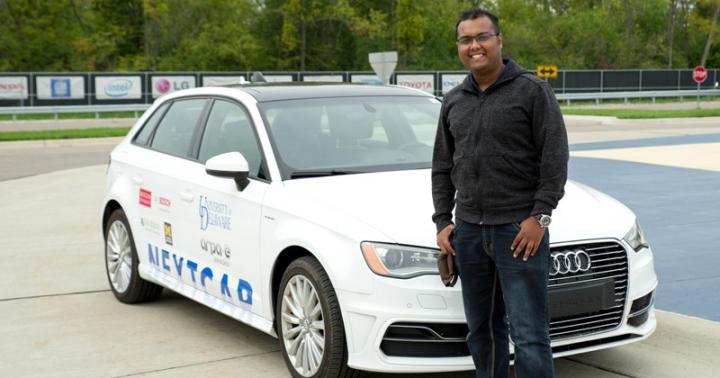UD research on connected and automated vehicles yields promising results

Credit: Photo courtesy of Ishti Mahbub
Imagine merging into busy traffic without ever looking over your shoulder nor accelerating or braking too hard, irritating the driver in the next lane over. Connected and automated vehicles that communicate to coordinate optimal traffic patterns could enable this pleasant driving scenario sooner than you think.
At the University of Delaware, a research group of students is developing algorithms for connected and automated vehicles that reduce energy consumption and travel delays. The Information and Decision Science Lab is led by Andreas Malikopoulos, Terri Connor Kelly and John Kelly Career Development Associate Professor.
Connected and automated vehicles use technology such as sensors, cameras and advanced control algorithms to adjust their operation to changing conditions with little or no input from drivers.
For doctoral student A M Ishtiaque Mahbub, the project has offered unprecedented opportunities. He is the first author of two new technical papers published by SAE — formerly known as the Society of Automotive Engineers — describing how UD engineers optimized vehicle dynamics and powertrain operation using connectivity and automation as well as how they developed and tested a control framework that reduced travel time and energy use in a connected and automated vehicle.
The team is optimizing an Audi A3 e-tron, a plug-in hybrid electric vehicle. First, the team members developed control architectures to reduce stop-and-go driving and travel time while ensuring that energy efficiency. Next, the team tested the algorithms using driving simulators in UD’s Spencer Laboratory.
Then, in October 2019, they put their work to the test in the University of Michigan’s MCity, a testing ground for cutting-edge vehicles. The software developed at UD went into the Audi A3 e-tron.
On test day, Mahbub stepped into the test car with two other engineers from Bosch. Each was equipped with a laptop to take data as they drove along a track that included a roundabout, merging zone, intersection and other challenges. The connected and automated vehicle is designed to take over and navigate these situations for you.
“This alleviates stress, and by eliminating stop-and-go driving behavior where you’re constantly braking and accelerating, braking and accelerating, or even yielding, it also has a smooth margin in those cases, which also as a byproduct increases the fuel efficiency,” said Mahbub.
Virtual reality was used to simulate challenges for the car to navigate around, such as other cars and pedestrians.
With months of preparation behind him, Mahbub was excited for the test, but nervous, too. “There is a certain level of uncertainty that plays on your mind, that, OK: The theory and control algorithms worked in simulation, but how about in the real world?” he said. “How might the real-world uncertainties and unknown variables affect the system?”
The test was a success, with a 30 percent increase in energy efficiency, more than the simulation even predicted.
The real-world scenario helped Mahbub put his analysis in context, gain an even greater understanding of the vehicle’s control architecture, and collect data that could be used to realize and quantify even greater gains in energy efficiency.
“At one point in the field test I was feeling a bit nauseous because the centrifugal force was a little too much,” he said. “I’m thinking right now going forward if we plan to visit MCity, I will definitely put that in my algorithm so that the passengers will have a more comfortable drive.”
###
This research is supported by the U.S. government-funded Advanced Research Projects Agency-Energy (ARPA-e) NEXTCAR project where U.D. Prof. Andreas Malikopoulos is the principal investigator. Research collaborators include the University of Michigan, Boston University, Bosch Corporation, and Oak Ridge National Laboratory.
Bosch is developing a prototype device that will include the algorithm and communication protocol developed at UD and will be compatible with a variety of vehicles.
Mahbub’s trip to Michigan was also supported by a University of Delaware Collection-Based Research Travel Grant.
Mahbub received his bachelor’s degree in mechanical engineering from Bangladesh University of Engineering and Technology in Bangladesh in 2013 and his master’s degree in computational mechanics from the University of Stuttgart in Germany in 2016.
Media Contact
Peter Kerwin
[email protected]
Original Source
https:/




